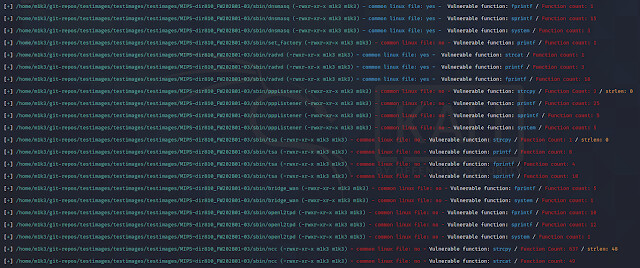
emba is being developed as a firmware scanner that analyses already-extracted Linux-based firmware images. It should help you to identify and focus on the interesting areas of a huge firmware image. Although emba is optimized for offline firmware images, it can test both, live systems and extracted images. Additionally, it can also analyze kernel configurations. emba is designed to assist a penetration tester. It is not designed as a standalone tool without human interaction. emba is designed to give as much information as possible about the firmware. The tester can decide on the areas to focus on and is always responsible for verifying and interpreting the results.
How to use it?
Before starting, check that all dependencies are met and use the installer.sh script: ./emba.sh -d or ./emba.sh -d -F
Arguments:
Test firmware / live system
-a [MIPS] Architecture of the linux firmware [MIPS, ARM, x86, x64, PPC]
-A [MIPS] Force Architecture of the linux firmware [MIPS, ARM, x86, x64, PPC] (disable architecture check)
-l [./path] Log path
-f [./path] Firmware path
-e [./path] Exclude paths from testing (multiple usage possible)
-m [MODULE_NO.] Test only with set modules [e.g. -m p05 -m s10 ... ]]
(multiple usage possible, case insensitive, final modules aren't selectable, if firmware isn't a binary, the p modules won't run)
-c Enable cwe-checker
-g Create grep-able log file in [log_path]/fw_grep.log
Schematic: MESSAGE_TYPE;MODULE_NUMBER;SUB_MODULE_NUMBER;MESSAGE
-E Enable automated qemu emulation tests (WARNING this module could harm your host!)
-D Run emba in docker container
-i Ignore log path check
Dependency check
-d Only check dependencies
-F Check dependencies but ignore errors
Special tests
-k [./config] Kernel config path
Modify output
-s Print only relative paths
-z Add ANSI color codes to log
Firmware details
-X [version] Firmware version (double quote your input)
-Y [vendor] Firmware vendor (double quote your input)
-Z [device] Device (double quote your input)
-N [notes] Testing notes (double quote your input)
Help
-h Print this help message
Docker Container
There is a simple docker-compose setup added which allows you to use emba in a docker container - see the wiki for more details
Examples
Static firmware testing:
- Extract the firmware from an update file or from flash storage with binwalk or something else
- Execute emba with set parameters, e.g.
sudo ./emba.sh -l ./logs/arm_test -f ./firmware/arm_firmware/
- Path for logs and firmware path are necessary for testing successfully (WARNING: emba needs some free disk space for logging)
- Architecture will be detected automatically; you can overwrite it with
-a [ARCH] - Use
-A [ARCH]if you don’t want to use auto detection for architecture - emba currently supports the following architectures: MIPS, ARM, PPC, x86 and x64
Live testing:
For testing live system with emba run it as if you were testing static firmware, but with / as firmware path:
sudo ./emba.sh -l ./logs/local_test -f /
- Path for logs and firmware path are necessary for testing successfully
- Architecture will be detected automatically; you can overwrite it with
-a [ARCH] - Use
-A [ARCH]if you don’t want to use auto detection for architecture - The paths
/procand/syswill be automatically excluded - It improves output and performance, if you exclude docker
-e /var/lib/docker
Test kernel config:
Test only a kernel configuration with the kernel checker of checksec:
sudo ./emba.sh -l ./logs/kernel_conf -k ./kernel.config
- If you add
-f ./firmware/x86_firmware/, it will ignore-kand search for a kernel config inside the firmware
Good to know:
sudois necessary for some modules to run properly- Currently only tested on Kali Linux(2020.4)
- emba needs some free disk space for logging
- emba uses well known tools like objdump, LinEnum, checksec, linux-exploit-suggester.sh, cwe-checker
- emba includes multiple modules of the well known Linux analyser Lynis
Dependencies
emba uses multiple other tools and components - see the wiki for more details
